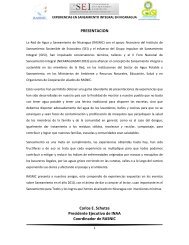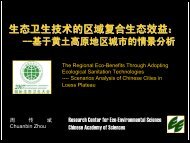<strong>Open</strong> <strong>Planning</strong> <strong>of</strong> <strong>Sanitation</strong> <strong>Systems</strong>• environmental sustainability• economic and financial, institutional, technical• social marketing approach to hygiene promotion and sanitation promotionThe interdisciplinary nature <strong>of</strong> the water supply and sanitation sector is then accounted for in each <strong>of</strong>the eight stages <strong>of</strong> the project cycle:1. Policy development, sector planning and programme formulation2. Programme and project identification3. Preparation4. Appraisal and approval5. Implementation and monitoring6. Operation and monitoring7. Extensions or next-phase project identification8. EvaluationThe water supply and sanitation programmes should be truly demand-responsive. They should workdirectly with primary stakeholders (the intended users <strong>of</strong> the systems) as well as with secondarystakeholders, such as the local government, donors, local NGOs, etc. This implies, among otherthings, that a participatory approach to the stakeholders should permeate each <strong>of</strong> the above programmedevelopment stages.Evaluation <strong>of</strong> the DFID Guidance manual from an ecosan perspectiveThe DFID Guidance manual is geared towards a programme level rather than project level. It does notinclude ecological sanitation in its technical options and even states that household management <strong>of</strong>nutrients poses a health hazard leading to difficulties in operation and management.ENVIRONMENTAL IMPACT ASSESSMENT (SIDA, 1998)Background/aim <strong>of</strong> toolThe Environmental Impact Assessment (EIA) is a systematic review <strong>of</strong> the positive and negativeconsequences <strong>of</strong> a project on the environment. It should be carried out during the initial stages <strong>of</strong> aproject to allow for early mitigation <strong>of</strong> revealed and unwanted effects <strong>of</strong> the project. The EIA identifiesalternative options and makes it easier to discover issues that otherwise would have been overlooked.The EU Council Directive 85/337/EEC On the Assessment <strong>of</strong> the Effects <strong>of</strong> Certain Public and PrivateProjects on the Environment states that an EIA should take into consideration direct or indirect effectson:• people, flora and fauna• land, water, air, climate and landscape• material assets and cultural heritage• interaction between the above-mentioned factorsEvaluation <strong>of</strong> EIA from an ecosan perspectiveThe EIA is not a planning or implementation tool as such, but rather a part <strong>of</strong> the project cycle.For sanitation projects it could be used to rank sanitation alternatives with regards to communitycircumstances.21
Elisabeth Kvarnström and Ebba af PetersensTOWARDS BETTER PROGRAMMING: A SANITATION HANDBOOK (UNICEF, 1997)Background/aim <strong>of</strong> toolThe handbook has been prepared to serve as a resource in planning realistic and better quality sanitationinterventions on a programme level rather than a project level. The programming process employsparticipatory methods, objective-oriented techniques, and key principles that reflect positive andnegative lessons learned about sanitation. The handbook should be seen as a guide for programmeplanners to use according to their need, specific location and time.Key issues addressed in the handbook are that the programme workers should act as catalysts in alearning, programming and policy-development process, rather than engaging in programme work forthe sake <strong>of</strong> implementation only. Team-building should be carried out on a national as well as a locallevel, and comprehensive and intensive stakeholder participation should take place at all programmestages.The overall design cycle for programming contains six different stages:1. Problem definition: Where we are now, what we know, and what we do not know, including defininga shared vision for the future2. Information gathering: What we need to know to make better decisions3. Analysis <strong>of</strong> issues and options: Selecting alternatives4. <strong>Planning</strong>: Charting out a strategy and programme design5. Implementation and monitoring6. Evaluation, analysis, and re-planningThe programming design cycle is expressed in the triple-A approach: assessment, analysis, and action.It can also be used in conjunction with the Logical Framework Approach.Evaluation <strong>of</strong> UNICEF Handbook from an ecosan perspectiveThe handbook is used on programme level rather than on project level. Agriculture, which would be part<strong>of</strong> an integrated view <strong>of</strong> sanitation, is not taken into consideration.CONCLUSIONS FROM THE HANDBOOK REVIEWThe reviewed planning tools are operating on different levels. The LFA and PHAST/SARAR tools canbe used for planning and implementation on the project level. The UNICEF Handbook and the DFIDGuidance Manual are tools for the implementation <strong>of</strong> sanitation and, in the case <strong>of</strong> the DFID GuidanceManual, <strong>of</strong> water supply programmes. These programme planning tools are using both participatoryapproaches and LFA at different stages <strong>of</strong> the programme cycle.None <strong>of</strong> the reviewed tools discuss in-depth links between sanitation and agriculture, where theobvious link is plant nutrients. In the sanitation context, nutrients pose a problem , whereas in agricultureand aquaculture they are beneficial. Soils, in tropical countries in particular, <strong>of</strong>ten have a low naturalnutrient content and would, therefore, benefit from fertilisation.One key issue emerging in all reviewed documents is the need for a widespread and extendedparticipatory approach involving all relevant stakeholder groups. The <strong>Sanitation</strong> Handbook, forexample, advocates extension <strong>of</strong> community involvement beyond the construction, stating that theuse <strong>of</strong> existing community organizations and the improvement <strong>of</strong> their organizational capacity andproblem solving skills are vital, as is the inclusion <strong>of</strong> the community in project design, management andfinancing (UNICEF, 1997).Moreover, there is a need for projects to be demand-driven to allow for a greater success potential.No single technology option should be prescribed. Instead, an array <strong>of</strong> options reflecting the consumer’spreferences and local conditions should be made available to the community (UNICEF, 1997; DFID,1997).22



![Project Document [PDF: 2.31 MB] - EcoSanRes](https://img.yumpu.com/51279385/1/184x260/project-document-pdf-231-mb-ecosanres.jpg?quality=85)












![Latrines à compost [high-resolution colour PDF: 12.3MB] - EcoSanRes](https://img.yumpu.com/31726141/1/185x260/latrines-a-compost-high-resolution-colour-pdf-123mb-ecosanres.jpg?quality=85)